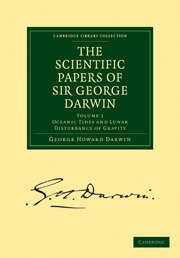Book contents
- Frontmatter
- PREFACE
- Contents
- Chronological List of Papers with References to the Volumes in which they probably will be contained
- PART I OCEANIC TIDES
- ART. 1 The Harmonic Analysis of Tidal Observations
- ART. 2 On the Periods Chosen for Harmonic Analysis, and a Comparison with the Older Methods by means of Hour-angles and Declinations
- ART. 3 Datum Levels: the Treatment of a Short Series of Tidal Observations and on Tidal Prediction
- ART. 4 A General Article on the Tides
- ART. 5 On the Harmonic Analysis of Tidal Observations of High and Low Water
- ART. 6 On an Apparatus for Facilitating the Reduction of Tidal Observations
- ART. 7 On Tidal Prediction
- ART. 8 On the Correction to the Equilibrium Theory of Tides for the Continents
- ART. 9 Attempted Evaluation of the Rigidity of the Earth from the Tides of Long Period
- ART. 10 Dynamical Theory of the Tides
- ART. 11 On the Dynamical Theory of the Tides of Long Period
- ART. 12 On the Antarctic Tidal Observations of the ‘Discovery’
- PART II THE LUNAR DISTURBANCE OF GRAVITY
- INDEX
- Plate section
ART. 12 - On the Antarctic Tidal Observations of the ‘Discovery’
Published online by Cambridge University Press: 07 September 2010
- Frontmatter
- PREFACE
- Contents
- Chronological List of Papers with References to the Volumes in which they probably will be contained
- PART I OCEANIC TIDES
- ART. 1 The Harmonic Analysis of Tidal Observations
- ART. 2 On the Periods Chosen for Harmonic Analysis, and a Comparison with the Older Methods by means of Hour-angles and Declinations
- ART. 3 Datum Levels: the Treatment of a Short Series of Tidal Observations and on Tidal Prediction
- ART. 4 A General Article on the Tides
- ART. 5 On the Harmonic Analysis of Tidal Observations of High and Low Water
- ART. 6 On an Apparatus for Facilitating the Reduction of Tidal Observations
- ART. 7 On Tidal Prediction
- ART. 8 On the Correction to the Equilibrium Theory of Tides for the Continents
- ART. 9 Attempted Evaluation of the Rigidity of the Earth from the Tides of Long Period
- ART. 10 Dynamical Theory of the Tides
- ART. 11 On the Dynamical Theory of the Tides of Long Period
- ART. 12 On the Antarctic Tidal Observations of the ‘Discovery’
- PART II THE LUNAR DISTURBANCE OF GRAVITY
- INDEX
- Plate section
Summary
The ‘Discovery’ wintered in 1902 and in 1903 at the south-eastern extremity of Ross Island, on which Mount Erebus is situated, in south latitude 78° 49′ and east longitude 166° 20′.
The station is near the west coast of a great bay in the Antarctic Continent, and the westerly coast line runs northward from the station for about 9° of latitude. To the eastward of the bay, however, the coast only attains a latitude of about 75° and follows approximately a small circle of latitude. Since the tide-wave comes from the east and travels to the west the station is not sheltered by the coast to the westward, and the continent to the eastward can do but little to impede the full sweep of the tide-wave in the Antarctic Ocean. It is true that Ross Island itself is partially to the east of the anchorage, but it is so small that its influence cannot be important. Of course the westward coast line must exercise an influence on the state of tidal oscillation, for regarding the tide-wave as a free wave coming in from the east, it is clear that it will run up to the end of the bay and then wheel round northward along the westerly coast. It would seem then that the situation is on the whole a good one for such observations. Of course their value would have been much increased if it had been possible to obtain other observations elsewhere.
- Type
- Chapter
- Information
- The Scientific Papers of Sir George DarwinOceanic Tides and Lunar Disturbance of Gravity, pp. 372 - 388Publisher: Cambridge University PressPrint publication year: 2009First published in: 1907



